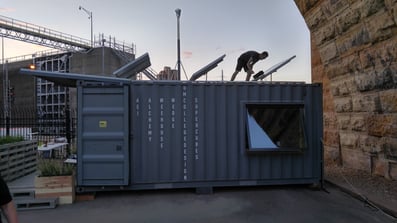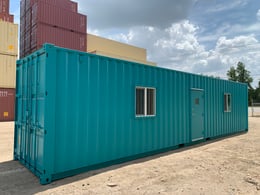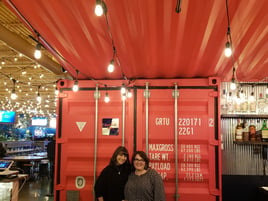Are you considering buying a shipping container? Whether you’re seeking a durable storage solution or planning to transform a container into an office, workshop, or even a living space, there are several important factors to keep in mind. Selecting the right container can significantly impact your project’s success, so it’s essential to ask the right questions.
In this article, we’ll explore key considerations to guide your purchase. We’ll discuss critical questions to ask yourself, potential modifications, and what to look for in terms of quality and usability. By the end, you’ll have a clearer understanding of how to choose the perfect shipping container for your specific needs.
Let’s dive into the essential questions you should consider before making your purchase.
What am I going to use it for?

How you plan to use your shipping container will significantly influence which type is best suited for your needs and how to effectively prepare for your purchase. By clearly defining your intended use, you’ll be in a better position to make informed decisions about all other aspects. For example, if you’re using the container for general storage of garage items, your requirements will differ greatly from someone looking to create a highly specialized, modified container for industrial applications.
To help you get started, consider some key factors:
- Size: Assess the space you have available and the volume of items you need to store. Shipping containers come in various sizes, typically 10, 20, and 40 feet, so choose one that fits your needs without wasting space.
- Condition: Decide whether you want a new or used container. New containers offer a clean, pristine appearance and durability, while used containers may provide cost savings but could require additional maintenance or repairs.
- Modifications: Think about any modifications you might need, such as windows, insulation, or shelving. A container for a workshop will have different requirements than one intended solely for storage.
- Shipping Logistics: Consider how and where your container will be shipped from. This can affect shipping costs and delivery times. Local suppliers may offer more convenient options, while distant suppliers might have a wider selection.
- Aesthetics: If the container will be visible in a public or residential area, consider how it will look. You might want to explore options for painting or customizing the exterior to fit in with your surroundings.
- Taking the time to reflect on these considerations and clarifying your end goals, you’ll find it much easier to identify the right shipping container for your specific needs.
What size do I need?
Most shipping containers are available in standard lengths of 20 feet and 40 feet, with heights typically ranging from 8 feet 6 inches for the standard models to 9 feet 6 inches for high-cube containers, which are often 40 feet long. Additionally, specialty containers measuring 45 feet are also available, providing an option for those needing extra space. All standard containers have a width of 8 feet, which remains consistent across sizes.
When considering a shipping container, it’s crucial to evaluate two key factors: the size that meets your specific needs and the space available at your intended location.
- Purpose: Think about what you will store or how you plan to use the container. For example, a 20-foot container might be sufficient for residential storage or a small workshop, while a 40-foot container could be necessary for larger projects or extensive inventory storage.
- Site Dimensions: Measure the area where you plan to place the container. Ensure that there’s enough space not only for the container itself but also for any additional access you might need, such as entry points or ventilation. Consider overhead clearance if the container will be placed near trees or structures.
- Accessibility: Consider how the container will be delivered and positioned. Some locations might require more maneuvering space for delivery trucks, especially for larger containers.
By carefully assessing these factors, you can ensure that the container you choose will fit your requirements both in terms of capacity and placement, leading to a smoother and more effective installation process.
What type of container do I need?
Are you in the market for a standard shipping container with doors on one short end? Or do you require a container with specialized features, such as doors on one long side for easier access, a tarp roof for better ventilation, or a removable steel roof for flexibility in use? Understanding your specific needs is crucial, as these additional features can come with extra costs.
When considering these options, it’s essential to keep in mind:
- Functionality: Think about how you will be using the container. For example, if you need frequent access to the contents, a container with doors on the long side may provide more convenience than a standard model.
- Weather Protection: If you plan to store items that are sensitive to weather conditions, a tarp roof may be beneficial, but be aware that it might not offer the same level of durability as a solid steel roof.
- Customization Options: If your needs extend beyond standard features, you may want to explore modifications. Customizations can include insulation, electrical wiring, windows, or even complete redesigns to suit specific operational requirements.
- Budget Considerations: While specialized containers can enhance functionality, they often come with higher price tags. It’s wise to set a budget that accounts for both the base container cost and any desired modifications.
Thus evaluating your requirements and understanding the implications of these choices, you can ensure that you select a container that perfectly aligns with your intended use while remaining within your budget.
What condition do I need?
Do you want your container to be fresh, clean and new (one-trip/”new”)? Does it matter if the container is used and has some rust and dents? Used containers are often painted, but it is easy enough to repaint your container once you’ve received it.
Do I need modifications and if so, who will do them?

Do you need to enhance your shipping container to better suit your needs? This could involve a variety of modifications, such as adding doors or windows for improved access and ventilation, installing insulation for temperature control, or incorporating heating and air conditioning systems to create a comfortable workspace. Additionally, if your project requires more space, you might consider combining multiple container units together to form a larger structure.
When contemplating modifications, it’s essential to determine whether you want these changes made before the container is delivered or if you plan to tackle the modifications yourself after the purchase. Here are a few factors to consider:
- Professional vs. DIY Modifications: If you choose to have modifications done before delivery, ensure you work with a reputable company that specializes in container modifications. This can save you time and ensure quality workmanship. However, if you’re handy and have the necessary skills, doing it yourself can be a cost-effective option, allowing for more personalized touches.
- Timeline: Custom modifications can extend the delivery timeline, so be sure to discuss the schedule with the supplier. If you need the container quickly, you might want to consider pre-modified options or focus on essential modifications that can be done later.
- Cost Implications: Keep in mind that modifications can add to the overall cost of the container. It’s important to budget accordingly and weigh the benefits of each modification against your overall project goals.
- Future Needs: Consider whether your needs might change in the future. Planning for additional modifications or scalability can help you create a more versatile setup that can adapt over time.
If you would like our help with doing the modifications, we can help with as much or as little as you would like. We do not do design work, so you would need to provide us with a drawing showing us where you would like the modifications to be done so we can price them out for you. Give us a call or write us and we’ll help you get started on the process.
How will my container get where I need it?
Consider your property carefully and the specific location where you intend to place the shipping container. The delivery process involves a large truck that requires adequate space to maneuver. Typically, a standard delivery truck will need between 80 to 130 feet of clearance to safely unload the container onto the ground.
When purchasing a shipping container, reputable suppliers will ask for your location. This information is crucial because delivery rates are influenced by the distance their trucks must travel to reach you. Each company has its own pricing structure, and transportation costs can vary significantly based on your geographic area.
Additionally, container prices can fluctuate from one market to another. Factors such as local demand, availability, and regional competition all play a role in determining the cost. Without providing at least a city and state or a zip code, it would be challenging for suppliers to offer you an accurate ballpark figure for both the container and the delivery.
To streamline the process, it’s beneficial to have this information ready when inquiring about pricing. This will not only help you get a clearer idea of the overall costs but also ensure that you find a container that fits both your needs and your budget.
Where can I buy a container from?
Once you’ve clearly defined what you want in a shipping container, the next step is exploring your options for purchasing one. While cost will certainly play a role in your decision, the reputation of the vendor is becoming increasingly critical. Unfortunately, the rise of scammers in this industry makes it essential to choose a trustworthy seller. Platforms like Craigslist and Facebook Marketplace, while convenient, can often be breeding grounds for fraud.
To help you navigate this landscape safely, here are some red flags to watch out for:
- Incomplete Company Information: Be cautious of sellers who provide little to no contact information, such as missing names, phone numbers, or business addresses. A reputable company should be transparent about its identity.
- Lack of History: Research the company’s history. If a vendor has no online presence, customer reviews, or established track record, it could be a warning sign.
- Inadequate Delivery Questions: A legitimate vendor will inquire about your property and the specifics of the delivery process. If they don’t ask about your location or access points, it may indicate a lack of professionalism.
- Mismatched Listings: If an advertisement describes one container but features a photo of a completely different model or condition, it’s a strong indication of a scam. Always ask for actual photos of the container you intend to purchase.
- Pricing That Seems Too Good to Be True: Be wary of prices that appear unusually low. If a deal seems exceptionally favorable compared to market rates, it may be a tactic to lure in unsuspecting buyers.
A reputable vendor will provide comprehensive information, including their business details, clear communication, and transparency throughout the purchasing process. Taking the time to choose a reliable seller can save you from potential headaches and ensure a smoother experience in acquiring your shipping container.

If you have questions on shipping containers and choosing the right option for you, we can help. Icontainer helps individuals and organizations source and obtain the right shipping container solutions for their unique needs. Reach out to our experienced team to get started.
Related
Related Projects
Choosing The Right Shipping Container: The Ultimate GuideSo you’ve decided to purchase a shipping container but need help figuring out where to start. This guide covers everything you should consider when choosing the right shipping container.28 minsSo you’ve decided to purchase a shipping container but need help figuring out where to...
Read More
Blog
October 12, 2024
Guide For Buying Shipping Containers: Things You Need To Know
Introduction Shipping containers are the backbone of global logistics, known for their durability, versatility, and ability to transport goods across land and sea. Beyond traditional shipping, these containers serve countless purposes, including storage, office space, retail units, and even homes. Whether you’re in the market for a container for shipping, storage,...
Read More
Blog
October 12, 2024
Buying Considerations for a shipping container.
How to buy a shipping container: 8 easy steps to followThere are various types of shipping containers available in the market, each with distinct conditions and gradings based on their usage and structural integrity. Choosing the right container type, understanding its condition, and finding the appropriate price are all crucial...
Read More
Blog
October 12, 2024
10 Essential Tips for Buying a Shipping Container
Category: Shipping ContainersDate: 12 October 2024If you’re considering buying a shipping container for storage, export, or conversion, you’ve come to the right place.If you’re thinking about buying a shipping container for storage, export, or conversion, you’re in the right place. This is a significant investment, making it crucial to make an...
Read More